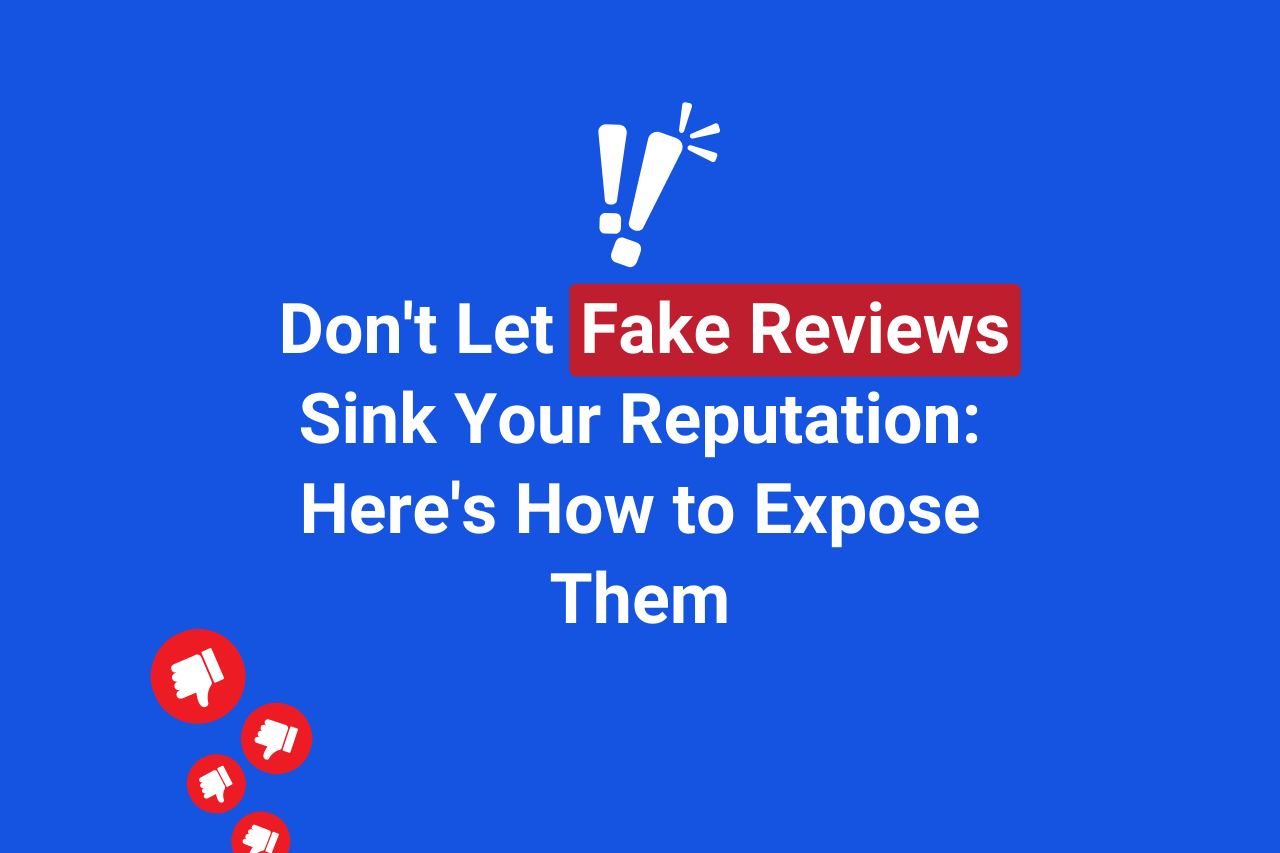
Don’t Let Fake Reviews Sink Your Reputation: Here’s How to Expose Them. Identify and counteract misleading feedback effectively.
In today’s digital age, online reviews significantly influence a business’s reputation. They act as a public endorsement, swaying potential customers either towards or away from a product or service.
However, the credibility of these reviews is sometimes undermined by the presence of fake critiques, intentionally crafted to mislead or harm a business. Addressing fake reviews is crucial, not only to maintain the integrity of your business’s online presence but also to ensure that potential customers receive honest and accurate information.
This isn’t just about protecting a brand image—it’s about fostering a trustworthy environment where genuine customer feedback can thrive. By tackling the issue of fake reviews, businesses safeguard their reputation and support consumer confidence.
Understanding Fake Reviews: Types and Motivations
Fake reviews are misleading evaluations posted on review platforms that do not reflect a genuine customer experience. Typically, they fall into three categories: malicious, competitor-driven, and paid. Malicious reviews aim to damage a business’s reputation without provocation, often stemming from personal grievances.
Competitor-driven reviews are posted by businesses attempting to undermine their rivals, creating a false impression of poor service or quality. Paid reviews are those where the reviewer is compensated to write favorable or unfavorable feedback, regardless of their actual experience with the product or service.
Understanding the motivations behind these deceptive practices is key to combating them effectively. Often, the driving force is economic gain; businesses may feel pressured to boost their online prestige quickly to attract more customers or deter others from patronizing competitors.
Additionally, in a digital marketplace where positive reviews can significantly elevate a business’s visibility and sales, the temptation to fabricate reviews becomes stronger.
Psychological factors also play a role. The anonymity of the internet provides a shield that might encourage unethical behavior like writing fake reviews, which individuals or businesses might not engage in under their real identity. This phenomenon, known as “online disinhibition effect,” illustrates how the digital realm can sometimes alter moral decision-making.
For businesses, the battle against fake reviews isn’t just about protecting their own interests—it’s about preserving trust in the review system as a whole, ensuring that consumers can make informed decisions based on honest, authentic feedback.
The Art of Spotting Fake Reviews
In the digital marketplace, distinguishing genuine feedback from deceptive reviews is crucial for maintaining the credibility of your business. Armed with the right knowledge and tools, companies can effectively shield their online reputation against the erosion caused by fake critiques.
This section delves into the characteristics that often betray a fake review and the sophisticated technological aids that can help in their detection.
Spotting the Signs of Fakery
Fake reviews often leave subtle clues that can signal their lack of authenticity. One common sign is the absence of specific details about the user’s experience, making the review sound vague and non-personal.
Excessive use of superlatives or extreme negativity without clear context can also be a red flag. Moreover, patterns of similarity in multiple reviews posted around the same time, or those that starkly contrast with the majority of feedback, can further suggest manipulation.
Leveraging Analytical Tools for Detection
To combat the challenge of fake reviews, numerous analytical tools have been developed. Programs like Fakespot and ReviewMeta utilize advanced algorithms to analyze review patterns and the authenticity of reviewer profiles.
These tools look for inconsistencies in the language, frequency, and timing of reviews that typically deviate from normal consumer behavior. Businesses can integrate these tools into their review management systems to automatically flag potential fakes, ensuring a more trustworthy review ecosystem and safeguarding their reputation.
Legal Battles and Ethical Frontiers in Review Management
The intersection of law and ethics in handling fake reviews is a critical frontier in digital business operations. As companies seek to purify their online testimonials from deceit, they must carefully balance robust legal strategies with the moral implications of their actions.
This delicate balance influences not only their compliance with regulations but also the public perception of their ethical standards.
Navigating Legal Frameworks
Different jurisdictions have distinct laws aimed at regulating the authenticity of online reviews. In the United States, the Federal Trade Commission (FTC) enforces guidelines that prohibit deceptive endorsements, ensuring reviews are honest and not misleading.
Similar regulations exist in the EU, where stringent measures can lead to significant fines for companies that engage in fake review practices. Businesses must stay informed about these legal frameworks to not only comply with the law but also foster a trustworthy environment for consumers.
Ethical Dilemma: Striking a Balance
Identifying and combating fake reviews poses significant ethical challenges. While it’s important to weed out deceitful content to protect your brand, there’s a risk of inadvertently dismissing genuine critiques.
Businesses must tread carefully, ensuring their methods for identifying fake reviews do not discourage real customers from sharing honest feedback. Establishing clear, transparent criteria for review verification can help mitigate these risks, fostering an environment where authentic voices are heard and valued, enhancing trust and credibility.
Steps to Take When You Spot a Fake Review
In the digital age, spotting a fake review is only half the battle; the real challenge lies in responding effectively. For businesses, the approach to dealing with deceitful feedback is twofold: direct engagement through review platforms and strategic public responses.
This proactive stance not only helps in mitigating the immediate damage but also reinforces a commitment to transparency and customer service, bolstering the brand’s integrity in the public eye.
Engaging with Review Platforms
When a suspicious review appears, the first line of defense is to contact the review platform. Each major platform like Google, Yelp, or Amazon has its own protocol for handling potentially fake reviews.
Typically, businesses can flag a review for further investigation directly through their interface. The process may involve submitting evidence that the review is likely fraudulent, such as inconsistencies found in the reviewer’s profile or history.
While platforms are cautious to ensure that genuine reviews are not unjustly removed, they also provide guidelines and support to help businesses navigate the reporting process effectively, ensuring that their review ecosystem remains trustworthy and balanced.
Crafting a Public Response
While you await the review platform’s investigation, crafting a thoughtful public response is vital. Responding publicly to a suspected fake review should be done with care to avoid potential backlash.
Acknowledge the feedback diplomatically and indicate that the claim is being investigated for accuracy. This approach not only shows other customers that your business takes feedback seriously but also that it handles criticism with professionalism.
Ensure that your response is calm, collected, and maintains your brand’s voice. This not only mitigates the impact of the fake review but also enhances your reputation for prospective customers who read how you handle such challenges.
Preventative Strategies and Best Practices for Managing Reviews
Crafting a proactive defense against fake reviews begins with fostering an environment that encourages genuine customer feedback and vigilantly monitoring your online presence.
Implementing these preventative measures not only diminishes the impact of fraudulent reviews but also strengthens the trust and loyalty of your customer base by showcasing your commitment to authenticity and continuous improvement.
Cultivating Authentic Customer Feedback
Encouraging real customers to leave genuine reviews is foundational to building a resilient review portfolio. Start by making the review process as easy and accessible as possible, integrating it seamlessly into the customer experience.
Follow up transactions with personalized emails or messages inviting feedback, and consider incentives like discounts or loyalty points for those who leave a review.
Transparency about the importance of honest reviews not only enhances engagement but also fosters a sense of community and trust. Additionally, engaging actively with reviewers by thanking them and addressing concerns shows that you value their input, which can motivate others to contribute their feedback.
Proactive Review Monitoring
Regularly monitoring and auditing your online reviews is crucial for early detection of any suspicious activities that could indicate fake reviews. Set up alerts for new reviews across all major platforms where your brand is present, and consider employing review monitoring software that can help streamline the process.
These systems can provide analytics that detect anomalies in review patterns, such as sudden spikes in activity or clusters of similar language across multiple reviews. Staying ahead with proactive monitoring allows businesses to respond swiftly to potential issues, maintaining the integrity of their online presence.
Final Thoughts
This article has equipped you with insights into identifying, managing, and preventing fake reviews, essential for protecting your business’s online reputation.
From understanding the nuances of fake reviews and employing sophisticated tools for their detection to navigating legal landscapes and ethical considerations, the stakes are high but manageable with the right approach. We’ve also discussed the importance of fostering genuine customer engagement and maintaining a vigilant watch over your review ecosystem.
Now, it’s your turn to implement these strategies. Stay proactive and vigilant. Encourage authentic feedback and consistently monitor your reviews to detect any signs of fraud early. By doing so, you ensure your business not only survives but thrives in the digital marketplace, bolstered by a foundation of trust and transparency.



